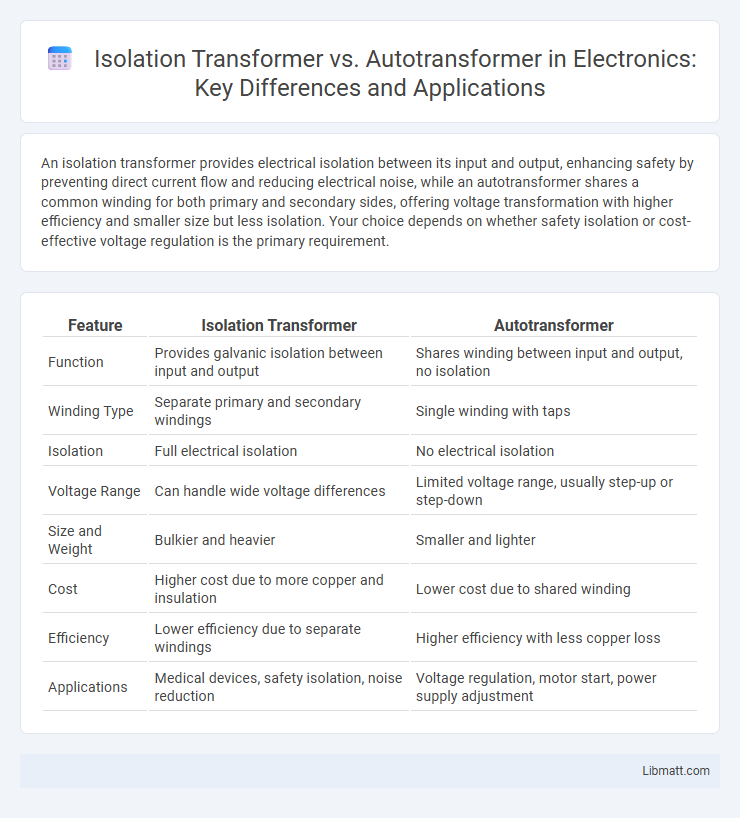An isolation transformer provides electrical isolation between its input and output, enhancing safety by preventing direct current flow and reducing electrical noise, while an autotransformer shares a common winding for both primary and secondary sides, offering voltage transformation with higher efficiency and smaller size but less isolation. Your choice depends on whether safety isolation or cost-effective voltage regulation is the primary requirement.
Table of Comparison
| Feature | Isolation Transformer | Autotransformer |
|---|---|---|
| Function | Provides galvanic isolation between input and output | Shares winding between input and output, no isolation |
| Winding Type | Separate primary and secondary windings | Single winding with taps |
| Isolation | Full electrical isolation | No electrical isolation |
| Voltage Range | Can handle wide voltage differences | Limited voltage range, usually step-up or step-down |
| Size and Weight | Bulkier and heavier | Smaller and lighter |
| Cost | Higher cost due to more copper and insulation | Lower cost due to shared winding |
| Efficiency | Lower efficiency due to separate windings | Higher efficiency with less copper loss |
| Applications | Medical devices, safety isolation, noise reduction | Voltage regulation, motor start, power supply adjustment |
Introduction: Understanding Transformers
Isolation transformers provide electrical isolation between the input and output, enhancing safety by preventing direct current flow and reducing electrical noise. Autotransformers share a common winding for input and output, offering efficient voltage conversion with reduced size and weight but lacking isolation. Choosing between the two depends on application requirements such as safety, voltage transformation ratio, and efficiency.
What is an Isolation Transformer?
An isolation transformer is a device designed to transfer electrical power while isolating the input from the output, ensuring no direct electrical connection between the primary and secondary windings. It provides safety by preventing shock hazards, reducing electrical noise, and protecting sensitive equipment from voltage spikes. Your equipment benefits from enhanced electrical isolation and noise reduction when using an isolation transformer compared to an autotransformer.
What is an Autotransformer?
An autotransformer is a type of electrical transformer with a single winding that acts as both the primary and secondary circuit, allowing voltage adjustment through a tap on the winding. It provides voltage transformation with greater efficiency and smaller size compared to isolation transformers because it shares a common winding rather than having two electrically isolated windings. Autotransformers are typically used when the voltage difference between the input and output is relatively small and electrical isolation is not required.
Key Differences Between Isolation Transformer and Autotransformer
Isolation transformers provide galvanic isolation between input and output windings, enhancing safety by preventing direct electrical connection and reducing noise interference, whereas autotransformers share a common winding for both input and output without isolation. Isolation transformers are typically used in applications requiring electrical isolation and voltage matching, while autotransformers are preferred for voltage regulation and stepping voltage up or down with higher efficiency and smaller size. The key difference lies in isolation capability, winding configuration, and typical use cases, influencing their selection for safety-critical or cost-sensitive applications.
Advantages of Isolation Transformers
Isolation transformers provide galvanic isolation, enhancing safety by preventing direct electrical connection between input and output circuits, which reduces the risk of electric shock. They effectively suppress electrical noise and transient voltage spikes, protecting sensitive equipment in medical, industrial, and audio applications. Their ability to isolate ground loops minimizes interference and ensures stable, clean power delivery for critical systems.
Benefits of Autotransformers
Autotransformers provide increased efficiency and reduced size compared to isolation transformers by sharing common winding sections, resulting in lower material costs and weight. They offer higher power capacity for a given size and improved voltage regulation due to reduced copper losses. Autotransformers are ideal for applications requiring voltage step-up or step-down without isolation, such as in motor starting and voltage adjustment in power distribution systems.
Common Applications: Isolation Transformer vs Autotransformer
Isolation transformers are commonly used in medical equipment, sensitive electronics, and industrial machinery to provide electrical isolation and protect against electric shock and noise interference. Autotransformers are frequently applied in voltage regulation, motor starting, and power distribution systems where size, weight, and cost efficiency are critical. Industries such as manufacturing, power utilities, and audio engineering rely on isolation transformers for safety and noise reduction, while autotransformers serve in applications requiring variable voltage control and energy savings.
Efficiency and Performance Comparison
Isolation transformers provide superior electrical isolation and noise reduction, enhancing safety and signal integrity, but typically have lower efficiency due to higher copper losses and larger core size. Autotransformers offer higher efficiency and better voltage regulation because they share a common winding, resulting in reduced copper usage and smaller physical size. Performance-wise, isolation transformers are preferred for sensitive equipment requiring galvanic isolation, whereas autotransformers excel in applications prioritizing compactness and energy efficiency.
Safety Considerations
Isolation transformers provide enhanced safety by electrically separating the input and output circuits, minimizing the risk of electric shock and equipment damage due to ground faults. Autotransformers lack galvanic isolation, which increases the potential for hazardous voltage transfer and reduces protection against electrical faults. Using isolation transformers is essential in sensitive applications where personnel safety and equipment protection are top priorities.
Choosing the Right Transformer for Your Needs
Choosing the right transformer depends on your application's voltage requirements, safety considerations, and budget. Isolation transformers provide galvanic isolation, enhancing safety and noise reduction, making them ideal for sensitive or medical equipment. Autotransformers offer a more compact, cost-effective solution when voltage conversion without isolation is sufficient for your electrical system.
Isolation transformer vs Autotransformer Infographic

 libmatt.com
libmatt.com